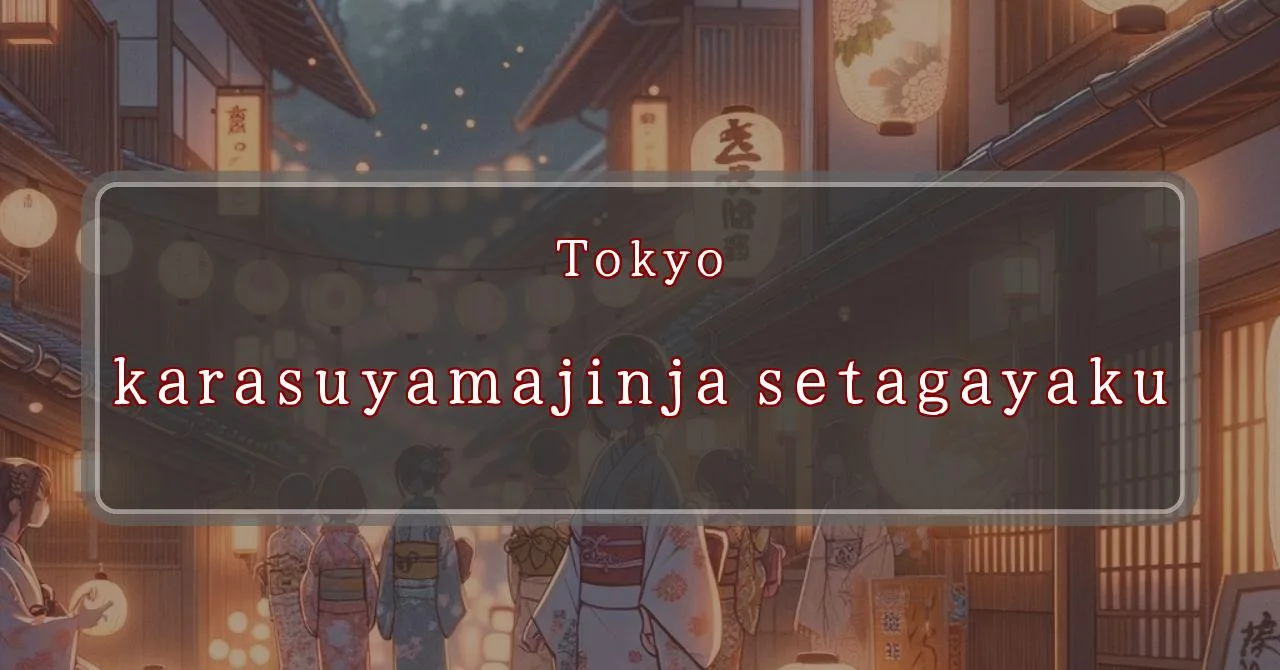Enchanting Shrine Festival in Tokyo: A Journey Through History and Tradition
Basic Information
Karasuyama Shrine is a Shinto shrine located in Setagaya Ward, Tokyo, Japan. It is dedicated to the deities of Mount Hakusan, Mount Ontake, Amaterasu, Ukanomitama, and Sugawara no Michizane.
- Address: 2-21-1 Minami-Karasuyama, Setagaya-ku, Tokyo 157-0062
- Phone Number: 03-3323-0456
- Access: 6-minute walk from Chitose-Karasuyama Station on the Keio Line, or an 8-minute walk from Asagaya Park Station on the Keio Line.
- Festival Days: September 23rd (Mon) and 24th (Tue), 2024
Main Events and Attractions of the Festival
The Karasuyama Shrine Festival is a two-day annual event held on September 23rd and 24th. It features a variety of traditional Japanese cultural performances and activities, as well as food and game stalls.
Mikoshi Procession
One of the main highlights of the festival is the mikoshi procession, where three portable shrines are carried through the streets of Karasuyama by local residents. The procession is accompanied by traditional Japanese music and dance, and it is a lively and colorful spectacle.
- Overview: Portable shrines are carried through the streets of Karasuyama.
- Features: Accompanied by traditional Japanese music and dance.
Kagura Performance
Kagura is a traditional Japanese Shinto ritual dance and music performance. During the Karasuyama Shrine Festival, kagura performances are held at the shrine’s kagura殿 (hall). These performances are a beautiful and sacred way to experience Japanese culture.
- Overview: Traditional Japanese Shinto ritual dance and music performance.
- Features: Held at the shrine’s kagura殿 (hall).
Food and Game Stalls
During the festival, the streets around Karasuyama Shrine are lined with food and game stalls. Visitors can enjoy a variety of traditional Japanese festival foods, such as yakitori (grilled chicken skewers), takoyaki (octopus balls), and kakigori (shaved ice with syrup). There are also a variety of games and activities for children, such as goldfish scooping and ring toss.
- Overview: Food and game stalls line the streets around Karasuyama Shrine.
- Features: Traditional Japanese festival foods, games, and activities for children.
Blessings and Deities
Karasuyama Shrine is dedicated to five deities: Shirakawa Hime no Okami, Ontake no Okami, Amaterasu Omikami, Ukanomitama no Okami, and Sugawara no Michizane. These deities are believed to bestow various blessings upon worshippers, including good fortune, prosperity, academic success, and safe childbirth.
- Shirakawa Hime no Okami: Goddess of matchmaking and縁結び (enmusubi, or縁結び).
- Ontake no Okami: Deity of mountains and agriculture.
- Amaterasu Omikami: Sun goddess and the most important deity in the Shinto pantheon.
- Ukanomitama no Okami: Deity of food and agriculture.
- Sugawara no Michizane: Scholar and statesman, deified as the god of learning and calligraphy.
Origin and History
The exact origins of Karasuyama Shrine are unknown, but it is believed to have been founded sometime during the Muromachi period (1336-1573). The shrine was originally known as Shirakawa Myojin, and it was dedicated to the deity Shirakawa Hime no Okami. In 1873, the shrine was renamed Karasuyama Shrine and moved to its current location.
- Founded: Muromachi period (1336-1573)
- Original name: Shirakawa Myojin
- Renamed: 1873
- Moved to current location: 1873
Tips and Notes for Visitors
Here are some tips and notes for visitors to the Karasuyama Shrine Festival:
- The festival is held on September 23rd and 24th each year.
- The mikoshi procession takes place on both days of the festival, starting at 11:00 AM on September 23rd and 10:00 AM on September 24th.
- The kagura performances are held at the shrine’s kagura殿 (hall) on both days of the festival, starting at 1:00 PM.
- There are food and game stalls lining the streets around the shrine on both days of the festival.
- The festival is a popular event, so it is recommended to arrive early to avoid crowds.
Parking Information
There is no dedicated parking lot for Karasuyama Shrine. However, there are several coin-operated parking lots in the area.
- SANパーク世田谷南烏山1
- SANパーク世田谷南烏山2
- SANパーク世田谷南烏山3
- タイムズ南烏山第9
- リパーク南烏山5丁目
Popular Stalls and Food Carts in Recent Years
| Type of Stall | Description |
|---|---|
| Takoyaki | A staple at Japanese festivals. Characterized by a crispy outside and a creamy inside. |
| Jaga Butter | A simple yet popular snack of hot potatoes lavishly topped with melted butter. |
| Baby Castella | Small castella cakes, sweet and fluffy treats enjoyed by children and adults alike. |
| Grilled Ayu with Salt | Fresh ayu fish grilled whole with salt, a savory taste of Japanese summer. |
| Shaapin | A unique gourmet item influenced by foreign cuisine, with a chewy skin wrapping the filling. |
| Okonomiyaki | A Japanese grilled dish where you often choose your own ingredients for a personalized flavor. |
| Cotton Candy | A fluffy, sweet snack that’s extremely popular with children. |
| Chocolate Banana | A banana coated in chocolate, a fun and visually appealing dessert. |
| Kushiyaki | Various types of ingredients skewered and grilled, an easy-to-enjoy snack. |
| Yakisoba | Fried noodles mixed with a special sauce, a fast food favorite in Japan. |



